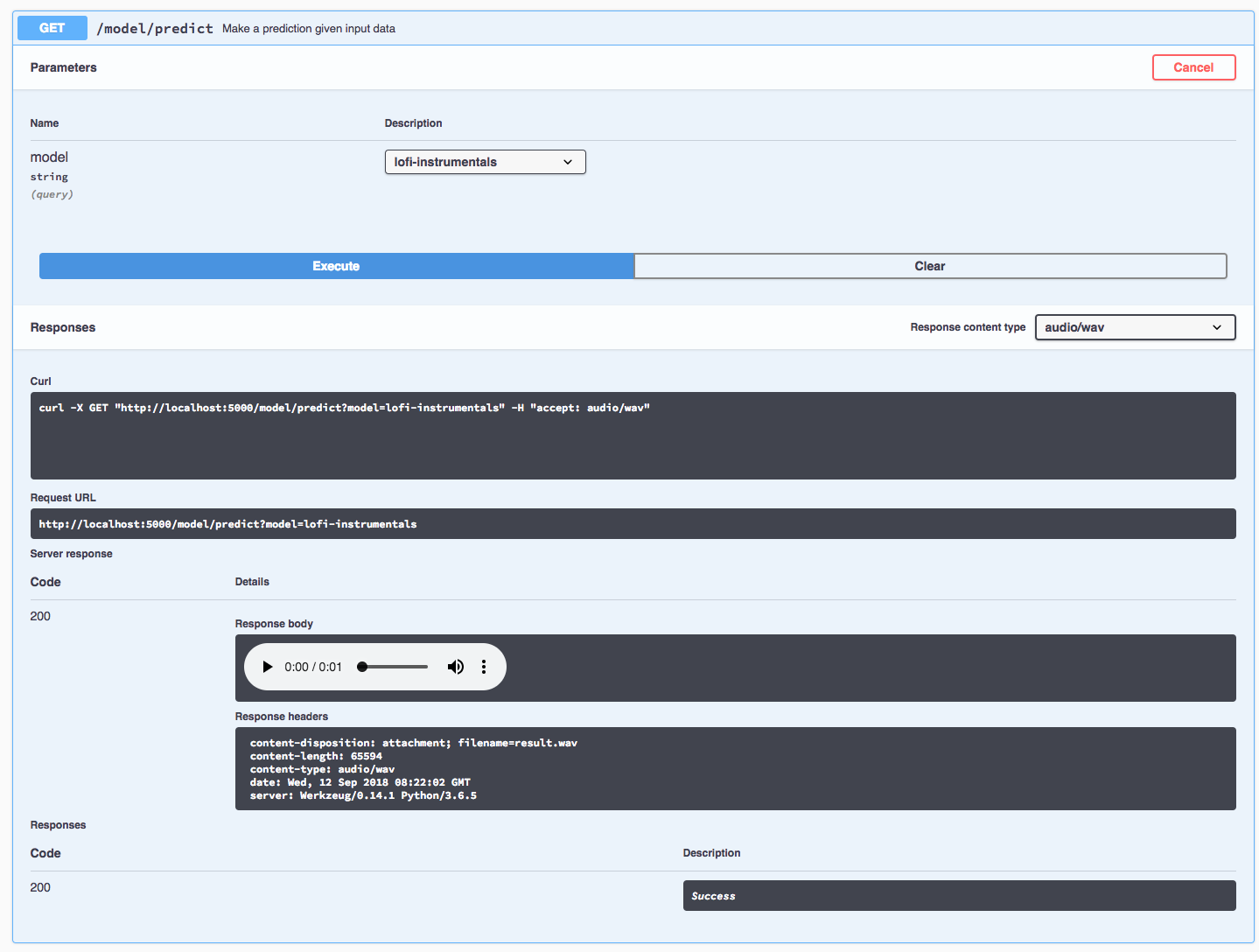This repository contains code to instantiate and deploy an audio generation model. The model generates short samples
based on an existing dataset of audio clips. It maps the sample space of the input data and generates audio clips that
are "inbetween" or "combinations" of the dominant features of the sounds. The model architecture is a generative
adversarial neural network, trained by the IBM CODAIT Team on lo-fi instrumental music tracks from the
Free Music Archive and short spoken commands from the
Speech Commands Dataset. The model can
generate 1.5 second audio samples of the words up, down, left, right, stop, go, as well as lo-fi
instrumental music.
The model is based on the WaveGAN Model. The model files are hosted on IBM Cloud Object Storage. The code in this repository deploys the model as a web service in a Docker container. This repository was developed as part of the IBM Code Model Asset Exchange and the public API is powered by IBM Cloud..
| Domain | Application | Industry | Framework | Training Data | Input Data Format |
|---|---|---|---|---|---|
| Audio | Audio Modeling | General | TensorFlow | Speech Commands & FMA tracks | None |
- Chris Donahue, Julian McAuley, Miller Puckette, "Synthesizing Audio with Generative Adversarial Networks", arXiv, 2018.
- WaveGAN Github repository
- Speech Commands Dataset release blog
- Free Music Archive
| Component | License | Link |
|---|---|---|
| This repository | Apache 2.0 | LICENSE |
| Model Weights | Apache 2.0 | LICENSE |
| Model Code (3rd party) | MIT | LICENSE |
docker: The Docker command-line interface. Follow the installation instructions for your system.- The minimum recommended resources for this model is 2GB Memory and 1 CPUs.
To run the docker image, which automatically starts the model serving API, run:
$ docker run -it -p 5000:5000 codait/max-audio-sample-generator
This will pull a pre-built image from Docker Hub (or use an existing image if already cached locally) and run it. If you'd rather checkout and build the model locally you can follow the run locally steps below.
You can also deploy the model on Kubernetes using the latest docker image on Docker Hub.
On your Kubernetes cluster, run the following commands:
$ kubectl apply -f https://github.com/IBM/MAX-Audio-Sample-Generator/raw/master/max-audio-sample-generator.yaml
The model will be available internally at port 5000, but can also be accessed externally through the NodePort.
A more elaborate tutorial on how to deploy this MAX model to production on IBM Cloud can be found here.
Clone this repository locally. In a terminal, run the following command:
$ git clone https://github.com/IBM/MAX-Audio-Sample-Generator.git
Change directory into the repository base folder:
$ cd MAX-Audio-Sample-Generator
To build the docker image locally, run:
$ docker build -t max-audio-sample-generator .
All required model assets will be downloaded during the build process. Note the model files for all audio types are extremely large and the download will take a while. Note that currently this docker image is CPU only (we will add support for GPU images later).
To run the docker image, which automatically starts the model serving API, run:
$ docker run -it -p 5000:5000 max-audio-sample-generator
The API server automatically generates an interactive Swagger documentation page. Go to http://localhost:5000 to load
it. From there you can explore the API and also create test requests.
Use the model/predict endpoint to generate an audio clip from one of the provided models, which can then be played in
the Swagger UI.
You can also test it on the command line. The model/predict endpoint returns a bytestream of the audio, which you can
then direct into a file using >; for example:
$ curl -X GET 'http://localhost:5000/model/predict' -H 'accept: audio/wav' > result.wav
This will save the generated wav file in the current directory.
You can generate samples for different classes of audio by setting the model request parameter to one of: up, down, left, right, stop, go or lofi-instrumentals (the default). For example to generate a sample of the word stop:
$ curl -X GET 'http://localhost:5000/model/predict?model=stop' -H 'accept: audio/wav' > stop.wav
To run the Flask API app in debug mode, edit config.py to set DEBUG = True under the application settings. You will
then need to rebuild the docker image (see step 1).
To stop the Docker container, type CTRL + C in your terminal.


